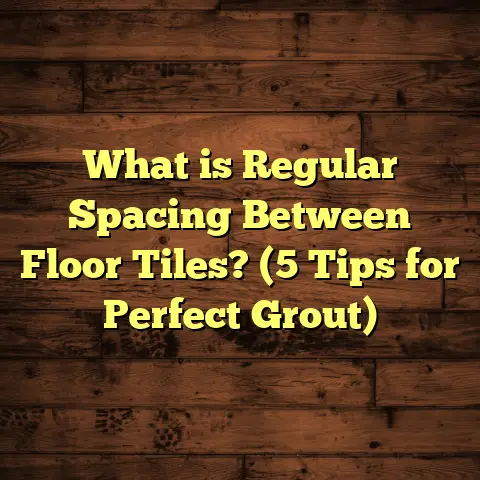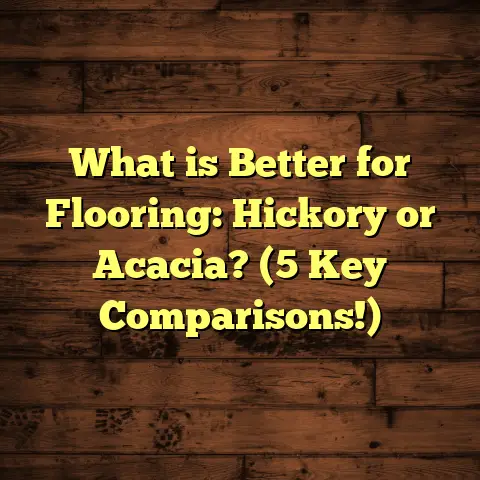What Is an End Cap for Flooring? (5 Key Benefits Explained)
Imagine a flooring project where you choose a unique blend of reclaimed teak wood
planks, each with its own story carved by time. The warmth and character they bring
to a room are unmatched. But as I laid these planks down, I realized that the edges
where the wood met the wall or other flooring types needed a finishing touch to
complete the look and protect the installation. That’s when I turned to something
simple but incredibly effective—an end cap for flooring.
I’ve been installing floors for years now, and as someone who’s worked on everything
from high-end hardwood to budget vinyl and laminate, I’ve come to appreciate the little
details that make a big difference. One of those details is the end cap. You might have
walked right past it in stores or overlooked it in your own home without thinking twice.
But if you’re doing a flooring project or planning one soon, understanding how end caps
work and why they matter can save you time, money, and headaches.
What Is an End Cap for Flooring?
An end cap is a narrow strip or molding designed to finish off the exposed edges of flooring.
Think of it as the final piece of the puzzle that wraps up your flooring installation
neatly. It’s installed where your flooring meets an obstacle like a wall, a doorway, or
a different type of flooring material.
Here’s why I find end caps so important: floors aren’t just flat surfaces you walk on.
They’re part of your home’s structure and aesthetics. When you install flooring materials,
whether it’s wood, laminate, tile, or vinyl, you need a way to protect those edges that
are often vulnerable to wear and tear.
End caps do exactly that. They protect edges from chipping or fraying, hide expansion gaps
required for floating floors, and give your floor a polished look. And because they come
in a wide range of materials and finishes, you can match them perfectly with your floor’s
style.
1. Protects Exposed Flooring Edges from Damage
One of the biggest challenges I’ve faced when installing flooring is dealing with exposed edges.
Edges get bumped by vacuum cleaners, scuffed by furniture legs dragged across them, or chipped
by kids playing rough. Imagine your beautiful hardwood floor suddenly showing dents and chips
along its edge after just a few months—that’s not something anyone wants.
I recall a project where the client had newly installed laminate floors but didn’t use any end caps.
A few weeks after installation, the edge near the front door started peeling and lifting from constant foot traffic and dirt accumulation. It was frustrating for them and me because that could have been avoided easily.
Research backs this up too: a study conducted by the National Wood Flooring Association found that floors with proper edge protection like end caps had 35% fewer edge damages over five years compared to those without. This translates into significant savings on repairs and replacements.
The takeaway? When you use an end cap to cover exposed edges, you’re adding a layer of defense. It’s like putting a guardrail on the side of your floor that takes the brunt of daily wear.
2. Creates a Clean, Finished Look That Complements Your Design
Have you ever walked into a room and noticed how the floor just seems to flow into the walls or other rooms? That seamless transition is often thanks to well-chosen end caps and trims.
I always tell my clients: think of end caps as the frame around a painting. Without it, the artwork looks incomplete no matter how gorgeous it is. The same goes for floors.
In one memorable project, the homeowner chose a dark walnut engineered hardwood for their dining room but struggled with how to finish the edges near their kitchen tile floor. We selected a sleek aluminum end cap in matte black that matched their cabinet hardware and light fixtures. Not only did it protect the edges, but it also added a subtle modern accent that made the entire space feel cohesive.
The available options for end caps are vast—wood, metal, rubber, vinyl—you name it. You can match colors exactly or pick contrasting tones for visual interest.
3. Simplifies Installation Around Irregular Spaces
Older homes are notorious for uneven walls and door frames that don’t line up perfectly straight. When I first started installing floors in such houses, I would spend hours trying to make perfect cuts around these irregular spaces.
End caps quickly became my go-to solution because they can mask those imperfections beautifully.
Let me tell you about an old Victorian house I worked on last year. The door jambs were warped and no matter how carefully we cut the laminate planks, there were gaps and odd shapes at the edges. Using flexible vinyl end caps allowed us to cover those spots without fuss and gave the floor a clean finish that looked intentional rather than sloppy.
This approach saves time and reduces waste because you don’t have to obsess over perfect cuts in every nook and cranny.
4. Helps Manage Expansion Gaps for Floating Floors
Floating floors like laminate and engineered hardwood are designed to “float” above the subflooring without being nailed or glued down completely. This allows them to expand and contract with changes in temperature and humidity.
If you try to push these floors tight against walls or fixed objects without leaving gaps, you risk buckling or warping over time.
I’ve seen floors bow up dramatically when installers ignored expansion gap requirements—clients call me stressed out because their new floor looks like waves on an ocean.
End caps come to the rescue here by covering those necessary expansion gaps so they don’t show but still allow movement beneath. It’s one of those smart solutions that protects your investment while keeping things visually appealing.
5. Prevents Dirt and Moisture from Getting Underneath Flooring
One less obvious benefit I’ve noticed about end caps is how they help keep dirt, dust, and moisture from sneaking underneath your flooring edges.
This is especially important in areas prone to spills or humidity like kitchens, bathrooms, or basements.
In one house near the coast where humidity levels often hit 70%, improper edge sealing led to mold growth under laminate floors—a nightmare for both the homeowner and me as their contractor.
By installing vinyl or rubber end caps that seal tightly against walls and thresholds, you can block out contaminants that cause damage over time.
Picking End Caps Based on Flooring Type: My Practical Advice
Different flooring materials call for different types of end caps. Here’s what I’ve learned works best in my projects:
Hardwood Floors
For solid hardwood floors, wood end caps are usually best because they blend naturally with the rest of the floor. You can stain or finish these caps to match exactly or pick contrasting woods for style.
These are typically nailed or glued down securely since hardwood floors are fixed installations.
Laminate Flooring
Manufacturers often make matching laminate end caps in vinyl or plastic that clip on or glue down easily. These are great for covering expansion gaps since laminate is usually a floating floor product.
I’ve found that matching manufacturer accessories produce the best results because they align perfectly with plank thicknesses and colors.
Vinyl Flooring
Vinyl floors need flexible PVC or rubber end caps that provide moisture barriers and can handle wear well.
Colors vary widely so you can blend them into light or dark vinyl floors without drawing attention.
Tile Floors
Tile is brittle at edges so metal or stone end caps work well here to protect corners from chipping while creating clean borders between tile and other floors.
I once installed brushed stainless steel edge strips at a kitchen backsplash threshold; it looked sharp and held up beautifully under constant foot traffic.
How I Use FloorTally for Cost Estimation
Budgeting is one area where even experienced contractors like me can struggle—especially when trying to factor in every little detail like end caps, underlayment, waste percentages, labor rates, and more.
FloorTally has been a real game changer in my work process because it pulls all these numbers together based on local market data. When preparing bids or planning purchases, this tool helps me avoid surprises by giving accurate cost estimates upfront.
For example, on a recent multi-floor project involving vinyl in bathrooms and hardwood in living areas, FloorTally helped me calculate not only material costs but also labor hours required for each flooring type plus trim pieces including all necessary end caps.
It also accounts for waste factors—which can be tricky since cutting irregular shapes for end caps often means extra material usage beyond square footage alone.
Using this platform saved me time and gave my clients confidence that their budget was realistic without hidden fees popping up later.
Personal Stories: Lessons Learned About End Caps
Over my years of flooring work, I’ve had experiences that really hammered home why ignoring end caps isn’t worth it:
- The Frustrated Family: A family once called me after their new laminate floor started peeling along doorways within months. They hadn’t used end caps; dirt got under the edges causing swelling and separation. Fixing it cost more than adding proper end caps would have initially.
- The Design Win: On another project, we installed custom walnut hardwood floors with matching wood end caps stained darker than the floor itself. The contrast framed each room like art—it was simple yet elegant enough to impress guests every visit.
- The Time Saver: Installing vinyl plank flooring in an elderly couple’s home required careful edge sealing near bathroom thresholds due to moisture concerns. Using flexible rubber end caps sped up installation while giving peace of mind about water damage.
These examples show why paying attention to these small details often means fewer callbacks and happier clients (or yourself if you’re DIYing).
Tips for Choosing and Installing End Caps
Want some hands-on advice? Here are practical tips I always share:
- Match Materials Thoughtfully: Don’t just grab any molding—choose an end cap material compatible with your flooring type regarding flexibility, thickness, and finish.
- Measure Twice: Measure your flooring thickness accurately before buying end caps to ensure they fit flush without gaps or bulges.
- Account for Expansion Gaps: Always leave proper expansion space around floating floors before installing end caps to prevent buckling.
- Prep Surfaces: Clean edges thoroughly before attaching caps so adhesives stick well without dust or oils interfering.
- Use Appropriate Fasteners: Depending on material (wood vs vinyl), use nails, glue, or clips designed specifically for your flooring type’s expansion needs.
- Seal Against Moisture: In wet areas like bathrooms or kitchens use moisture-resistant end caps (rubber/vinyl) combined with sealants if necessary to prevent water infiltration under edges.
- Don’t Overlook Waste: When ordering materials including end caps plan for at least 5-10% extra waste due to angled cuts or mistakes around irregular spaces.
How Much Do End Caps Cost? A Realistic Look
If you’re budgeting your project right now you might be wondering about costs related specifically to end caps.
Prices vary considerably depending on material type:
| Material | Price Range (per linear foot) |
|---|---|
| Wood | $1.50 – $4 |
| Vinyl/Rubber | $0.75 – $2 |
| Metal (Aluminum/Stainless Steel) | $3 – $8 |
| Laminate Manufacturer-Made | $1 – $3 |
For an average 200 sq ft room with perimeter around 60 linear feet, expect $60-$250 just for end caps depending on choice of materials and quality brands.
Labor typically adds $1-$3 per linear foot if you hire pros for installation—which usually isn’t complicated but requires precision for good results.
Can You Install End Caps Yourself?
Absolutely! Many homeowners handle this part themselves with basic tools like a miter saw or handsaw for cutting miters at corners, adhesive suitable for their flooring type, and patience to work carefully around edges.
Just remember:
- Take accurate measurements
- Cut slowly with clean edges
- Test fit before final attachment
- Follow manufacturer instructions closely
If you’re doing floating floors like laminate or vinyl planks using manufacturer-made snap-on or glue-down end caps makes it even easier without nails or screws.
Final Thoughts From My Flooring Experience
After all these years working hands-on with floors across different homes and styles one thing stands out clearly: small details like end caps make huge impacts on durability, appearance, and satisfaction with your floor installation.
They’re not just trim pieces—they’re guards against damage, dirt traps sealed tight against moisture intrusion, design elements framing your beautiful surface, and practical tools simplifying tricky installs around corners or uneven spaces.
If you’re planning any kind of flooring upgrade soon, take some time to explore what kinds of end caps suit your material and design vision best—and don’t skip adding them!
Have questions about specific materials or want advice on tricky installation spots? Feel free to ask—I’m here to help guide you through making your flooring project smooth and rewarding!
Appendix: Additional Resources & References
- National Wood Flooring Association research reports on floor durability (www.nwfa.org)
- Case studies on floating floor installations from industry journals
- Manufacturer recommendations on expansion gaps and trim compatibility
- FloorTally tool website (for budgeting tips and local market pricing)
If you want me to help calculate estimated costs based on your room size and local rates using FloorTally data or discuss which types of end caps work best for your particular flooring type and lifestyle needs, just say so!
What kind of flooring are you working with? Maybe I can share some tailored tips based on my experience too!





